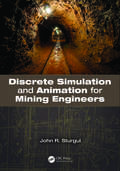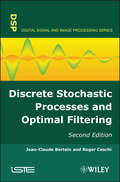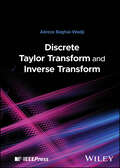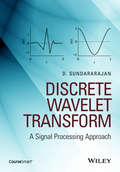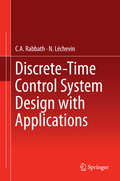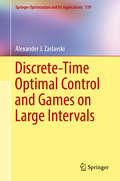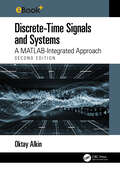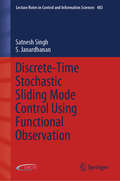- Table View
- List View
Discrete Simulation and Animation for Mining Engineers
by John SturgulGeneral Purpose Simulation System (GPSS) is a special computer programming language primarily used to simulate what can be classified as discrete systems. A discrete system is one where, at any given instant in time, a countable number of things can take place. The basic operation of a mine itself can be considered such a system. Discrete Simulatio
Discrete Stochastic Models and Applications for Reliability Engineering and Statistical Quality Control
by Serkan EryilmazDiscrete stochastic models are tools that allow us to understand, control, and optimize engineering systems and processes. This book provides real-life examples and illustrations of models in reliability engineering and statistical quality control and establishes a connection between the theoretical framework and their engineering applications. The book describes discrete stochastic models along with real-life examples and explores not only well-known models, but also comparatively lesser known ones. It includes definitions, concepts, and methods with a clear understanding of their use in reliability engineering and statistical quality control fields. Also covered are the recent advances and established connections between the theoretical framework of discrete stochastic models and their engineering applications. An ideal reference for researchers in academia and graduate students working in the fields of operations research, reliability engineering, quality control, and probability and statistics.
Discrete Stochastic Processes and Optimal Filtering (Wiley-iste Ser.)
by Jean-Claude Bertein Roger CeschiOptimal filtering applied to stationary and non-stationary signals provides the most efficient means of dealing with problems arising from the extraction of noise signals. Moreover, it is a fundamental feature in a range of applications, such as in navigation in aerospace and aeronautics, filter processing in the telecommunications industry, etc. This book provides a comprehensive overview of this area, discussing random and Gaussian vectors, outlining the results necessary for the creation of Wiener and adaptive filters used for stationary signals, as well as examining Kalman filters which are used in relation to non-stationary signals. Exercises with solutions feature in each chapter to demonstrate the practical application of these ideas using MATLAB.
Discrete Stochastic Processes and Optimal Filtering (Wiley-iste Ser.)
by Jean-Claude Bertein Roger CeschiOptimal filtering applied to stationary and non-stationary signals provides the most efficient means of dealing with problems arising from the extraction of noise signals. Moreover, it is a fundamental feature in a range of applications, such as in navigation in aerospace and aeronautics, filter processing in the telecommunications industry, etc. This book provides a comprehensive overview of this area, discussing random and Gaussian vectors, outlining the results necessary for the creation of Wiener and adaptive filters used for stationary signals, as well as examining Kalman filters which are used in relation to non-stationary signals. Exercises with solutions feature in each chapter to demonstrate the practical application of these ideas using Matlab.
Discrete Systems and Digital Signal Processing with MATLAB (Electrical Engineering Textbook Ser.)
by Taan S. ElAli"Discrete linear systems and digital signal processing have been treated for years in separate publications. ElAli has skillfully combined these two subjects into a single and very useful volume. � Useful for electrical and computer engineering students and working professionals� a nice addition to the shelves of academic and public libraries. "Sum
Discrete Taylor Transform and Inverse Transform
by Alireza Baghai-WadjiRevolutionize the calculation of mixed derivatives with this groundbreaking text Transform and inverse transform techniques, such as the Fourier transform and the Laplace transform, enable scientists and engineers to conduct research and design in transformed domains where the work is simpler, after which the results can be converted back into the real domain where they can be applied or actualized. This latter stage in the process, the inverse transform, ordinarily poses significant challenges. New transform/inverse transform techniques carry extraordinary potential to produce revolutionary new science and engineering solutions. Discrete Taylor Transform and Inverse Transform presents the groundbreaking discovery of a new transform technique. Placing a novel emphasis on the “position variable” and “derivative operator” as main actors, the Discrete Taylor Transform and Inverse Transform (D-TTIT) will facilitate the calculation of mixed derivatives of multivariate functions to any desired order. The result promises to create new applications not only in its allied fields of quantum physics and quantum engineering, but potentially much more widely. Readers will also find: Discussion of possible applications in electrical engineering, acoustics, photonics, and many more Analysis of functions depending on one, two, or three independent variables Tools for theoreticians and practitioners to design their own algorithms for solving specific boundary-value problems Discrete Taylor Transform and Inverse Transform is ideal for any scientific or engineering professional looking to understand a cutting-edge research and design tool.
Discrete Time Systems and Signal Processing
by S. PalaniThis book is designed to serve as a textbook for courses offered to undergraduate students enrolled in the Electrical, Electronics, Communications, and Instrumentation Engineering disciplines. The book presents a clear and comprehensive introduction to digital signal processing. For easier comprehension, the course contents of all the chapters are in sequential order. A variety of examples and solved problems are included in the book to enable application and ease of understanding of theoretical concepts. Every chapter contains several homework problems with answers followed by question-and-answer-type assignments. The detailed coverage and pedagogical tools make this an ideal textbook for students and researchers enrolled in electrical engineering and related programs.
Discrete Wavelet Transform: A Signal Processing Approach (Coursesmart Ser.)
by D. SundararajanProvides easy learning and understanding of DWT from a signal processing point of view Presents DWT from a digital signal processing point of view, in contrast to the usual mathematical approach, making it highly accessible Offers a comprehensive coverage of related topics, including convolution and correlation, Fourier transform, FIR filter, orthogonal and biorthogonal filters Organized systematically, starting from the fundamentals of signal processing to the more advanced topics of DWT and Discrete Wavelet Packet Transform. Written in a clear and concise manner with abundant examples, figures and detailed explanations Features a companion website that has several MATLAB programs for the implementation of the DWT with commonly used filters “This well-written textbook is an introduction to the theory of discrete wavelet transform (DWT) and its applications in digital signal and image processing.” -- Prof. Dr. Manfred Tasche - Institut für Mathematik, Uni Rostock Full review at https://zbmath.org/?q=an:06492561
Discrete Wavelet Transformations: An Elementary Approach with Applications
by Patrick J. Van FleetUpdated and Expanded Textbook Offers Accessible and Applications-First Introduction to Wavelet Theory for Students and Professionals The new edition of Discrete Wavelet Transformations continues to guide readers through the abstract concepts of wavelet theory by using Dr. Van Fleet’s highly practical, application-based approach, which reflects how mathematicians construct solutions to challenges outside the classroom. By introducing the Haar, orthogonal, and biorthogonal filters without the use of Fourier series, Van Fleet allows his audience to connect concepts directly to real-world applications at an earlier point than other publications in the field. Leveraging extensive graphical displays, this self-contained volume integrates concepts from calculus and linear algebra into the constructions of wavelet transformations and their applications, including data compression, edge detection in images and denoising of signals. Conceptual understanding is reinforced with over 500 detailed exercises and 24 computer labs. The second edition discusses new applications including image segmentation, pansharpening, and the FBI fingerprint compression specification. Other notable features include: Two new chapters covering wavelet packets and the lifting method A reorganization of the presentation so that basic filters can be constructed without the use of Fourier techniques A new comprehensive chapter that explains filter derivation using Fourier techniques Over 120 examples of which 91 are “live examples,” which allow the reader to quickly reproduce these examples in Mathematica or MATLAB and deepen conceptual mastery An overview of digital image basics, equipping readers with the tools they need to understand the image processing applications presented A complete rewrite of the DiscreteWavelets package called WaveletWare for use with Mathematica and MATLAB A website, www.stthomas.edu/wavelets, featuring material containing the WaveletWare package, live examples, and computer labs in addition to companion material for teaching a course using the book Comprehensive and grounded, this book and its online components provide an excellent foundation for developing undergraduate courses as well as a valuable resource for mathematicians, signal process engineers, and other professionals seeking to understand the practical applications of discrete wavelet transformations in solving real-world challenges.
Discrete and Continuous Fourier Transforms: Analysis, Applications and Fast Algorithms
by Eleanor ChuLong employed in electrical engineering, the discrete Fourier transform (DFT) is now applied in a range of fields through the use of digital computers and fast Fourier transform (FFT) algorithms. But to correctly interpret DFT results, it is essential to understand the core and tools of Fourier analysis. Discrete and Continuous Fourier Transform
Discrete and Continuous Models in the Theory of Networks (Operator Theory: Advances and Applications #281)
by Delio Mugnolo Fatihcan M. Atay Pavel B. KurasovThis book contains contributions from the participants of the research group hosted by the ZiF - Center for Interdisciplinary Research at the University of Bielefeld during the period 2013-2017 as well as from the conclusive conference organized at Bielefeld in December 2017. The contributions consist of original research papers: they mirror the scientific developments fostered by this research program or the state-of-the-art results presented during the conclusive conference.The volume covers current research in the areas of operator theory and dynamical systems on networks and their applications, indicating possible future directions. The book will be interesting to researchers focusing on the mathematical theory of networks; it is unique as, for the first time, continuous network models - a subject that has been blooming in the last twenty years - are studied alongside more classical and discrete ones. Thus, instead of two different worlds often growing independently without much intercommunication, a new path is set, breaking with the tradition. The fruitful and beneficial exchange of ideas and results of both communities is reflected in this book.
Discrete-Event Modeling and Simulation: A Practitioner's Approach (Computational Analysis, Synthesis, and Design of Dynamic Systems)
by Gabriel A. WainerComplex artificial dynamic systems require advanced modeling techniques that can accommodate their asynchronous, concurrent, and highly non-linear nature. Discrete Event systems Specification (DEVS) provides a formal framework for hierarchical construction of discrete-event models in a modular manner, allowing for model re-use and reduced development time. Discrete Event Modeling and Simulation presents a practical approach focused on the creation of discrete-event applications. The book introduces the CD++ tool, an open-source framework that enables the simulation of discrete-event models. After setting up the basic theory of DEVS and Cell-DEVS, the author focuses on how to use the CD++ tool to define a variety of models in biology, physics, chemistry, and artificial systems. They also demonstrate how to map different modeling techniques, such as Finite State Machines and VHDL, to DEVS. The in-depth coverage elaborates on the creation of simulation software for DEVS models and the 3D visualization environments associated with these tools. A much-needed practical approach to creating discrete-event applications, this book offers world-class instruction on the field’s most useful modeling tools.
Discrete-Event Modeling and Simulation: Theory and Applications (Computational Analysis, Synthesis, and Design of Dynamic Systems)
by Pieter J. Mosterman Gabriel A. WainerCollecting the work of the foremost scientists in the field, Discrete-Event Modeling and Simulation: Theory and Applications presents the state of the art in modeling discrete-event systems using the discrete-event system specification (DEVS) approach. It introduces the latest advances, recent extensions of formal techniques, and real-world examples of various applications. The book covers many topics that pertain to several layers of the modeling and simulation architecture. It discusses DEVS model development support and the interaction of DEVS with other methodologies. It describes different forms of simulation supported by DEVS, the use of real-time DEVS simulation, the relationship between DEVS and graph transformation, the influence of DEVS variants on simulation performance, and interoperability and composability with emphasis on DEVS standardization. The text also examines extensions to DEVS, new formalisms, and abstractions of DEVS models as well as the theory and analysis behind real-world system identification and control. To support the generation and search of optimal models of a system, a framework is developed based on the system entity structure and its transformation to DEVS simulation models. In addition, the book explores numerous interesting examples that illustrate the use of DEVS to build successful applications, including optical network-on-chip, construction/building design, process control, workflow systems, and environmental models. A one-stop resource on advances in DEVS theory, applications, and methodology, this volume offers a sampling of the best research in the area, a broad picture of the DEVS landscape, and trend-setting applications enabled by the DEVS approach. It provides the basis for future research discoveries and encourages the development of new applications.
Discrete-Event Simulation and System Dynamics for Management Decision Making
by Leonid Churilov Brian Dangerfield Sally BrailsfordIn recent years, there has been a growing debate, particularly in the UK and Europe, over the merits of using discrete-event simulation (DES) and system dynamics (SD); there are now instances where both methodologies were employed on the same problem. This book details each method, comparing each in terms of both theory and their application to various problem situations. It also provides a seamless treatment of various topics--theory, philosophy, detailed mechanics, practical implementation--providing a systematic treatment of the methodologies of DES and SD, which previously have been treated separately.
Discrete-Event Simulation: Concepts and Production in Arena (ISTE Consignment)
by Abdessalem JerbiThe use of discrete-event simulation in various fields, such as in industry, logistics and public health, has really taken off over the last few decades. The implementation of discrete-event simulation does however require an understanding, and perhaps even a mastery, of precise theoretical and methodological principles. Discrete-Event Simulation presents the key concepts involved in any discrete-event simulation project, covering the most frequently used techniques for analysing data and results, the methodological and practical aspects of implementing discrete-event simulation, along with an introduction to the use of the “Arena” discrete-event simulation tool. This book combines the elements presented with applied examples, as well as numerous examples of simulation projects in various fields.
Discrete-Time Control System Design with Applications
by C. A. Rabbath N. LéchevinThis unique book provides a bridge between digital control theory and vehicle guidance and control practice. It presents practical techniques of digital redesign and direct discrete-time design suitable for a real-time implementation of controllers and guidance laws at multiple rates and with and computational techniques. The theory of digital control is given as theorems, lemmas, and propositions. The design of the digital guidance and control systems is illustrated by means of step-by-step procedures, algorithms, and case studies. The systems proposed are applied to realistic models of unmanned systems and missiles, and digital implementation.
Discrete-Time Inverse Optimal Control for Nonlinear Systems
by Edgar N. Sanchez Fernando Ornelas-TellezDiscrete-Time Inverse Optimal Control for Nonlinear Systems proposes a novel inverse optimal control scheme for stabilization and trajectory tracking of discrete-time nonlinear systems. This avoids the need to solve the associated Hamilton-Jacobi-Bellman equation and minimizes a cost functional, resulting in a more efficient controller. Design More Efficient Controllers for Stabilization and Trajectory Tracking of Discrete-Time Nonlinear Systems The book presents two approaches for controller synthesis: the first based on passivity theory and the second on a control Lyapunov function (CLF). The synthesized discrete-time optimal controller can be directly implemented in real-time systems. The book also proposes the use of recurrent neural networks to model discrete-time nonlinear systems. Combined with the inverse optimal control approach, such models constitute a powerful tool to deal with uncertainties such as unmodeled dynamics and disturbances. Learn from Simulations and an In-Depth Case Study The authors include a variety of simulations to illustrate the effectiveness of the synthesized controllers for stabilization and trajectory tracking of discrete-time nonlinear systems. An in-depth case study applies the control schemes to glycemic control in patients with type 1 diabetes mellitus, to calculate the adequate insulin delivery rate required to prevent hyperglycemia and hypoglycemia levels. The discrete-time optimal and robust control techniques proposed can be used in a range of industrial applications, from aerospace and energy to biomedical and electromechanical systems. Highlighting optimal and efficient control algorithms, this is a valuable resource for researchers, engineers, and students working in nonlinear system control.
Discrete-Time Optimal Control and Games on Large Intervals
by Alexander J. ZaslavskiDevoted to the structure of approximate solutions of discrete-time optimal control problems and approximate solutions of dynamic discrete-time two-player zero-sum games, this book presents results on properties of approximate solutions in an interval that is independent lengthwise, for all sufficiently large intervals. Results concerning the so-called turnpike property of optimal control problems and zero-sum games in the regions close to the endpoints of the time intervals are the main focus of this book. The description of the structure of approximate solutions on sufficiently large intervals and its stability will interest graduate students and mathematicians in optimal control and game theory, engineering, and economics. This book begins with a brief overview and moves on to analyze the structure of approximate solutions of autonomous nonconcave discrete-time optimal control Lagrange problems. Next the structures of approximate solutions of autonomous discrete-time optimal control problems that are discrete-time analogs of Bolza problems in calculus of variations are studied. The structures of approximate solutions of two-player zero-sum games are analyzed through standard convexity-concavity assumptions. Finally, turnpike properties for approximate solutions in a class of nonautonomic dynamic discrete-time games with convexity-concavity assumptions are examined.
Discrete-Time Recurrent Neural Control: Analysis and Applications (Automation and Control Engineering)
by Edgar N. SanchezThe book presents recent advances in the theory of neural control for discrete-time nonlinear systems with multiple inputs and multiple outputs. The simulation results that appear in each chapter include rigorous mathematical analyses, based on the Lyapunov approach, to establish its properties. The book contains two sections: the first focuses on the analyses of control techniques; the second is dedicated to illustrating results of real-time applications. It also provides solutions for the output trajectory tracking problem of unknown nonlinear systems based on sliding modes and inverse optimal control scheme. "This book on Discrete-time Recurrent Neural Control is unique in the literature, with new knowledge and information about the new technique of recurrent neural control especially for discrete-time systems.The book is well organized and clearly presented. It will be welcome by a wide range of researchers in science and engineering, especially graduate students and junior researchers who want to learn the new notion of recurrent neural control. I believe it will have a good market.It is an excellent book after all."— Guanrong Chen, City University of Hong Kong "This book includes very relevant topics, about neural control. In these days, Artificial Neural Networks have been recovering their relevance and well-stablished importance, this due to its great capacity to process big amounts of data. Artificial Neural Networks development always is related to technological advancements; therefore, it is not a surprise that now we are being witnesses of this new era in Artificial Neural Networks, however most of the developments in this research area only focuses on applicability of the proposed schemes. However, Edgar N. Sanchez author of this book does not lose focus and include both important applications as well as a deep theoretical analysis of Artificial Neural Networks to control discrete-time nonlinear systems. It is important to remark that first, the considered Artificial Neural Networks are development in discrete-time this simplify its implementation in real-time; secondly, the proposed applications ranging from modelling of unknown discrete-time on linear systems to control electrical machines with an emphasize to renewable energy systems. However, its applications are not limited to these kind of systems, due to their theoretical foundation it can be applicable to a large class of nonlinear systems. All of these is supported by the solid research done by the author."— Alma Y. Alanis, University of Guadalajara, Mexico "This book discusses in detail; how neural networks can be used for optimal as well as robust control design. Design of neural network controllers for real time applications such as induction motors, boost converters, inverted pendulum and doubly fed induction generators has also been carried out which gives the book an edge over other similar titles. This book will be an asset for the novice to the experienced ones."— Rajesh Joseph Abraham, Indian Institute of Space Science & Technology, Thiruvananthapuram, India
Discrete-Time Signals and Systems: A MATLAB Integrated Approach
by Oktay AlkinDrawing on author’s 30+ years of teaching experience, ”Discrete-Time Signals and Systems: A MATLAB Integrated Approach” represents a novel and comprehensive approach to understanding signals and systems theory. Many textbooks use MATLAB as a computational tool, but Alkin’s text employs MATLAB both computationally and pedagogically to provide interactive, visual reinforcement of fundamental concepts important in the study of discrete-time signals and systems.In addition to 204 traditional end-of-chapter problems and 160 solved examples, the book includes hands-on MATLAB modules consisting of: 108 MATLAB-based homework problems and projects (coordinated with the traditional end-of-chapter problems) 44 live scripts and GUI-based interactive apps that animate key figures and bring core concepts to life Downloadable MATLAB code for most of the solved examples 92 fully detailed MATLAB exercises that involve step by step development of code to simulate the relevant signal and/or system being discussed, including some case studies on topics such as real-time audio processing, synthesizers, electrocardiograms, sunspot numbers, etc. The ebook+ version includes clickable links that allow running MATLAB code associated with solved examples and exercises in a browser, using the online version of MATLAB. It also includes audio and video files for some of the examples. Each module or application is linked to a specific segment of the text to ensure seamless integration between learning and doing. The aim is to not simply give the student just another toolbox of MATLAB functions, but to use the development of MATLAB code as part of the learning process, or as a litmus test of students’ understanding of the key concepts. All relevant MATLAB code is freely available from the publisher. In addition, a solutions manual, figures, presentation slides and other ancillary materials are available for instructors with qualifying course adoption.
Discrete-Time Sliding Mode Control for Networked Control System (Studies In Systems, Decision And Control #132)
by Axaykumar Mehta Dipesh H. ShahThis book presents novel algorithms for designing Discrete-Time Sliding Mode Controllers (DSMCs) for Networked Control Systems (NCSs) with both types of fractional delays namely deterministic delay and random delay along with different packet loss conditions such as single packet loss and multiple packet loss that occur within the sampling period. Firstly, the switching type and non-switching type algorithms developed for the deterministic type fractional delay where the delay is compensated using Thiran’s approximation technique. A modified discrete-time sliding surface is proposed to derive the discrete-time sliding mode control algorithms. The algorithm is further extended for the random fractional delay with single packet loss and multiple packet loss situations. The random fractional delay is modelled using Poisson’s distribution function and packet loss is modelled by means of Bernoulli’s function. The condition for closed loop stability in all above situations are derived using the Lyapunov function. Lastly, the efficacy of the proposed DSMC algorithms are demonstrated by extensive simulations and also experimentally validated on a servo system.
Discrete-Time Sliding Mode Protocols for Discrete Multi-Agent System (Studies in Systems, Decision and Control #303)
by Axaykumar Mehta Keyurkumar PatelThis book presents few novel Discrete-time Sliding Mode (DSM) protocols for leader-following consensus of Discrete Multi-Agent Systems (DMASs). The protocols intend to achieve the consensus in finite time steps and also tackle the corresponding uncertainties. Based on the communication graph topology of multi-agent systems, the protocols are divided into two groups, namely (i) Fixed graph topology and (ii) Switching graph topology. The coverage begins with the design of Discrete-time Sliding Mode (DSM) protocols using Gao’s reaching law and power rate reaching law for the synchronization of linear DMASs by using the exchange of information between the agents and the leader to achieve a common goal. Then, in a subsequent chapter, analysis for no. of fixed-time steps required for the leader-following consensus is presented. The book also includes chapters on the design of Discrete-time Higher-order Sliding Mode (DHSM) protocols, Event-triggered DSM protocols for the leader-following consensus of DMASs. A chapter is also included on the design of DHSM protocols for leader-following consensus of heterogeneous DMASs.Special emphasis is given to the practical implementation of each proposed DSM protocol for achieving leader-following consensus of helicopter systems, flexible joint robotic arms, and rigid joint robotic arms. This book offers a ready reference guide for graduate students and researchers working in the areas of control, automation, and communication engineering, and in particular the cooperative control of multi-agent systems. It will also benefit professional engineers working to design and implement robust controllers for power systems, autonomous vehicles, military surveillance, smartgrids/microgrids, vehicle traffic management, robotic teams, and aerial robots.
Discrete-Time Stochastic Sliding Mode Control Using Functional Observation (Lecture Notes in Control and Information Sciences #483)
by Satnesh Singh S. JanardhananThis book extrapolates many of the concepts that are well defined for discrete-time deterministic sliding-mode control for use with discrete-time stochastic systems. It details sliding-function designs for various categories of linear time-invariant systems and its application for control. The resulting sliding-mode control addresses robustness issues and the functional-observer approach reduces the observer order substantially. Sliding-mode control (SMC) is designed for discrete-time stochastic systems, extended so that states lie within a specified band, and able to deal with incomplete information. Functional-observer-based SMC is designed for various clauses of stochastic systems: discrete-time; discrete-time with delay; state time-delayed; and those with parametric uncertainty. Stability considerations arising because of parametric uncertainty are taken into account and, where necessary, the effects of unmatched uncertainties mitigated. A simulation example is used to explain the use of the functional-observer approach to SMC design. Discrete-Time Stochastic Sliding-Mode Control Using Functional Observation will interest all researchers working in sliding-mode control and will be of particular assistance to graduate students in understanding the changes in design philosophy that arise when changing from continuous- to discrete-time systems. It helps to pave the way for further progress in applications of discrete-time SMC.
Discrete-Time and Discrete-Space Dynamical Systems (Communications and Control Engineering)
by Lihua Xie Lijun Zhang Kuize ZhangDiscrete-Time and Discrete-Space Dynamical Systems provides a systematic characterization of the similarities and differences of several types of discrete-time and discrete-space dynamical systems, including:Boolean control networks;nondeterministic finite-transition systems;finite automata;labelled Petri nets; andcellular automata.The book's perspective is primarily based on topological properties though it also employs semitensor-product and graph-theoretic methods where appropriate. It presents a series of fundamental results: invertibility, observability, detectability, reversiblity, etc., with applications to systems biology.Academic researchers with backgrounds in applied mathematics, engineering or computer science and practising engineers working with discrete-time and discrete-space systems will find this book a helpful source of new understanding for this increasingly important class of systems. The basic results to be found within are of fundamental importance for further study of related problems such as automated synthesis and safety control in cyber-physical systems using formal methods.
Discrete-continuum Coupling Method to Simulate Highly Dynamic Multi-scale Problems
by Mohamed Jebahi Ivan Iordanoff Frédéric Dau Jean-Luc CharlesComplex behavior models (plasticity, crack, visco-elascticity) are facing several theoretical difficulties in determining the behavior law at the continuous (macroscopic) scale. When homogenization fails to give the right behavior law, a solution is to simulate the material at a mesoscale using the discrete element model (DEM) in order to directly simulate a set of discrete properties that are responsible for the macroscopic behavior. Originally, the discrete element model was developed for granular material. This book, the second in the Discrete Element Model and Simulation of Continuous Materials Behavior set of books, shows how to choose the adequate coupling parameters to avoid spurious wave reflection and to allow the passage of all the dynamic information both from the fine to the coarse model and vice versa. The authors demonstrate the coupling method to simulate a highly nonlinear dynamical problem: the laser shock processing of silica glass.
